The final book in the Arks of Omen series is here, and it’s a doozy. With rules for the last remaining factions plus an entirely new one, two full sets of missions, and a pile of datasheets, it’s chock-full of content. But is it worth your time and money? Read on to find out.
As always, thanks to Games Workshop for a preview copy of the book.
The Lore
This is the final book in the Arks of Omen campaign series and it’s an absolute doozy, delivering a properly epic conclusion that will actually leave fans of almost every faction satisfied with the action and the conclusion. If you want to avoid spoilers–and reading the fluff section in this book is worth your time if you have any interest at all–skip this part of the review, as it’ll discuss what happens in the book.
+++ BEGIN SPOILERS FOR ARKS OF OMEN: THE LION +++
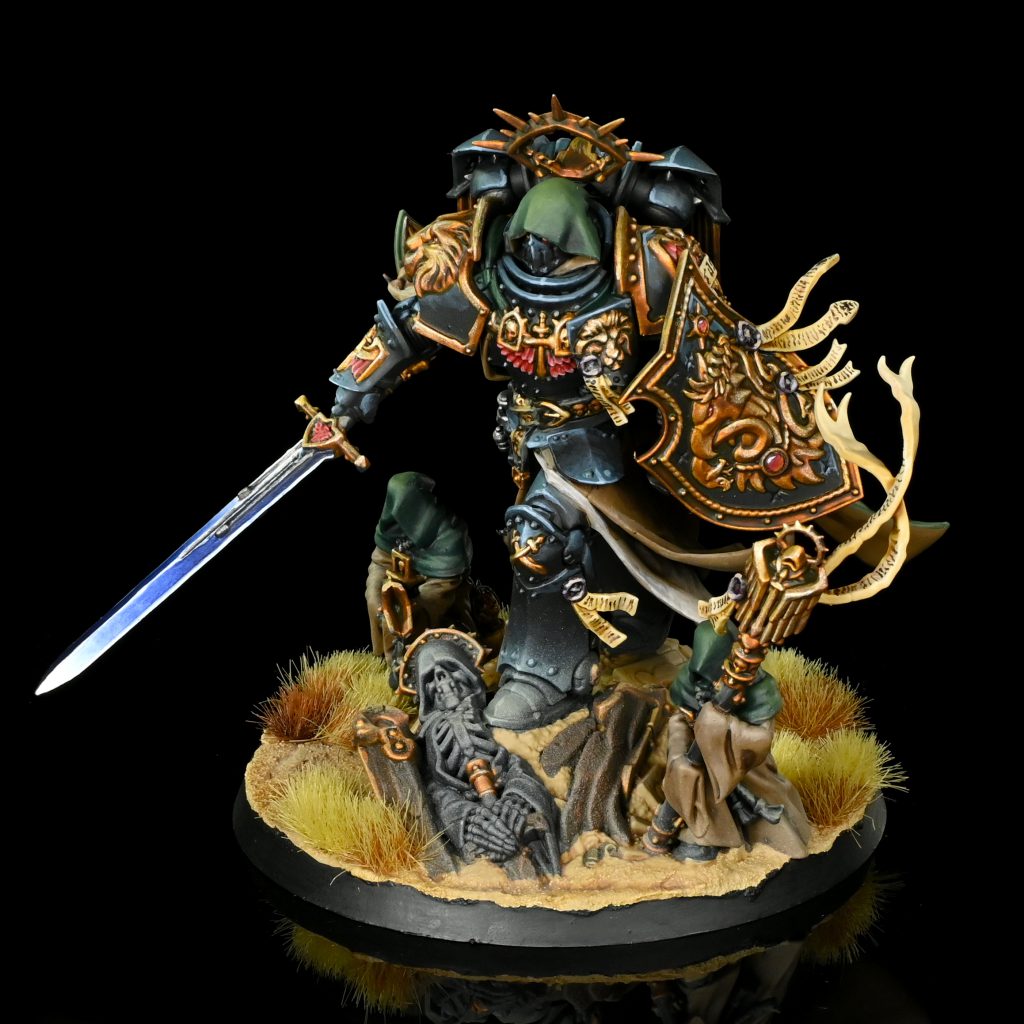
We cut right to the chase, opening on the Lion sparring with three of his formerly Fallen comrades – now called The Risen – on the deck of the Blood Angels’ flagship. The Lion is back, having been picked up by the Blood Angels. Or rather, he never left – he’s just been kind of hanging around in the shadows, popping up here and there to kill Chaos guys over the last ten thousand years. Now he’s decided to make his presence known once again and he’s pardoned all of the Fallen. Well, except for Luther and the ones who turned to full Chaos. He’s going to murder those guys.
The Blood Angels are on their way to the Somnium Stars to help the Dark Angels, who spent the prior weeks ducking out of battles and gathering every one of their successors together into a massive fleet hellbent on chasing down Vashtorr and Abaddon. They follow the obvious trap clue toward the Somnium Stars, bringing The Rock and the entire might of an old-school legion to bear on the traitors.
And when they arrive we finally get to see what Vashtorr has been building. All those doodads and seemingly worthless objects? Turns out they’re all parts of Caliban, scattered through the warp ten millennia ago when the planet was sundered by Luther and the Lion’s battle. They’ve been cobbled together into a massive, twisted copy of Caliban, meant to replicate its psychic signal. The Dark Angels aren’t thrilled with this blasphemy, and fly into a rage that leaves them open to attack. The go full bore into the assault, and while they’re doing that, Vashtorr is able to slip aboard the Rock and steal the final piece they need for The Key – the Tuchulcha Engine.
Meanwhile on the surface of this fake Caliban, the Dark Angels are getting their asses kicked, in part because Angron has been summoned to wreck house. Just as things are at their most dire however Dante shows up with the Lion, who teleports down to the planet and decides to solo Angron while the rest of his sons fight with renewed strength. The fight between Angron and the Lion goes how you’d expect, with the Lion basically outsmarting an enraged Angron and eventually banishing his ass back to the warp. Meanwhile, Vashtorr reunites the Tuchulcha Engine with the Plagueheart and with his rebuilt Caliban is able to recreate the Ouroborous. Together these create The Key, which seems to be a Webway tunneling device, the kind of thing the Old Ones used to create new webway. The Key is activated and Abaddon, Vashtorr, and the planet vanish into the warp.
The conclusion is pretty satisfying all-around. The Dark Angels get their Primarch back and the Imperium gain a powerful new ally while vanquishing Angron again for a time, while on the other side we get to see the rare Chaos “W” as Abaddon and Vashtorr get what they came for and the stage is set for future conflicts. Abaddon and Vashtorr don’t know what the Key unlocks or where the lock even is, but the Key is itself sentient and Vashtorr assures the Warmaster that the key really, really wants to be used so once they build it, it’ll take them where they want to go. Abaddon isn’t thrilled he has to deal with another loyalist primarch in order to conquer the galaxy, but he’s pretty hype about The Key. The only one who really loses here is Angron, but it’s pretty clear coming into this as the only major character who can be killed without actually dying that he’s not going to win a fight against the newly returned Lion. That said, as lame as the rage monster version of Angron is, he did get a pretty solid showing of his own in Arks of Omen: Angron.
And so 9th edition lore concludes, with Abaddon and Vashtorr triumphant and off in search of some new fresh technological horror left behind by the Old Ones while the Lion has returned to his sons in their time of greatest need. The story itself here is really solid, with lots of cool details and moments between the Lion and the Risen, the Lion and his sons, Dante and the Dark Angels, and Abaddon and Vashtorr. It’s worth picking up just to read, and it’s by far the strongest lore of any of the campaign books released in 8th or 9th.
+++ END SPOILERS +++
The Rules
After Farsight, there were still three factions who didn’t have rules for Boarding Actions games: the Leagues of Votann, Thousand Sons, and Adeptus Custodes. We’re happy to report that all three factions pick up rules here, together with a surprise bonus faction: Agents of the Imperium, which draws units not only from the various oddball factions contained in Kill Team releases over the past few years, but also things like Inquisitors, their various hangers-on, and Assassins.
Leagues of Votann
Votann have a very limited unit roster in Boarding Actions, with several of their strongest options not being legal choices. That said, they’ve got plenty of enhancements and stratagems to get the most out of the units they can take. True champions of the Kindred can inspire their fellows to display The Strength of the Hold, allowing all friendly units within 6” who aren’t engaged with enemies to Set to Defend. Less collectively-minded Kahls, meanwhile, can enter battle wearing the Vyrdelve Plate, which gives them an extra wound and adds 1 to armor saves they make.
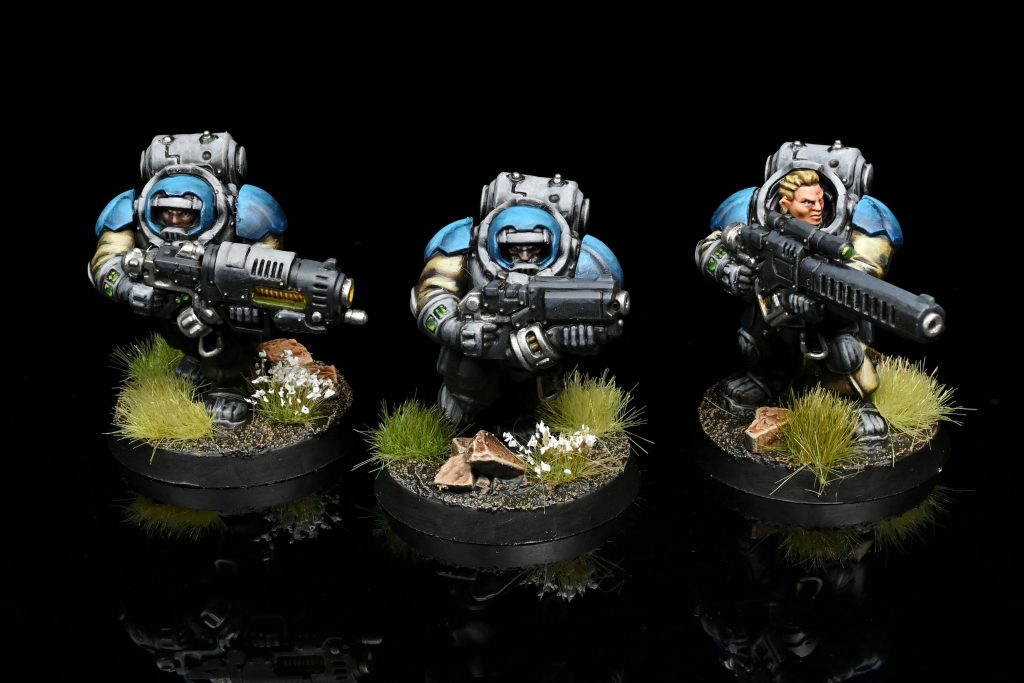
Hatchway Overrides offers the Leagues some more control over the battlefield, letting them automatically win the roll-off if they or their enemy decide to contest an attempt to open or close a hatchway. This allows a squad of Hearthkyn to deny access to a key route for your opponents, or for Hearthguard or Berserks to force their way into combat when your opponent would prefer otherwise. Focused Gravitic Blast offers more utility, allowing a unit with the Concussion keyword to knock 1 off their target’s hit rolls for the next turn, push them out of Overwatch or Set to Defend, and stop them from performing actions. And if you’re looking for a bit more offensive punch, Exacting Focus improves the AP of a unit’s ranged weapons by 1 for your shooting phase.
The Leagues are already reasonably strong, and these rules certainly don’t hurt them, adding some nifty utility rules as well as some more straightforward boosts to damage and survivability. The additional tools they gain access to let them shore up some of the holes in their strategy and take control of the flow of the game in ways other factions have trouble doing. All in all, a solid set of rules.
Thousand Sons
Rob: Like other factions, the Thousand Sons carry forward their rules from the Boarding Actions Mustering Rules download that came out a few months ago, giving you some minor adjustments, such as letting you take Chaos Spawns (which then gain the Fated Mutation upgrade free, which is pretty solid and makes them very much worth taking in a boarding patrol). The rules also adjust the cost of several powers upward, and makes the Malevolent Charge Cabbalistic Ritual costs 5 Cabal Points.
There are three enhancements here: Master of the Malefic Conduit gives you +D3 Cabal points per psychic phase, Walker of Fractured Ways lets the bearer move through one closed Hatchway per Movement phase, and Dominator of Fate lets you pick a unit within 9” each Command phase and it automatically gets to count as Holding Steady and being Set to Defend when it Overwatches and Fights. These are pretty solid, and those first two in particular bring a lot to the table. Though generally speaking, you may have to bring Master of the Malefic Conduit if you actually want to use Cabbalistic Rituals as part of your game plan.
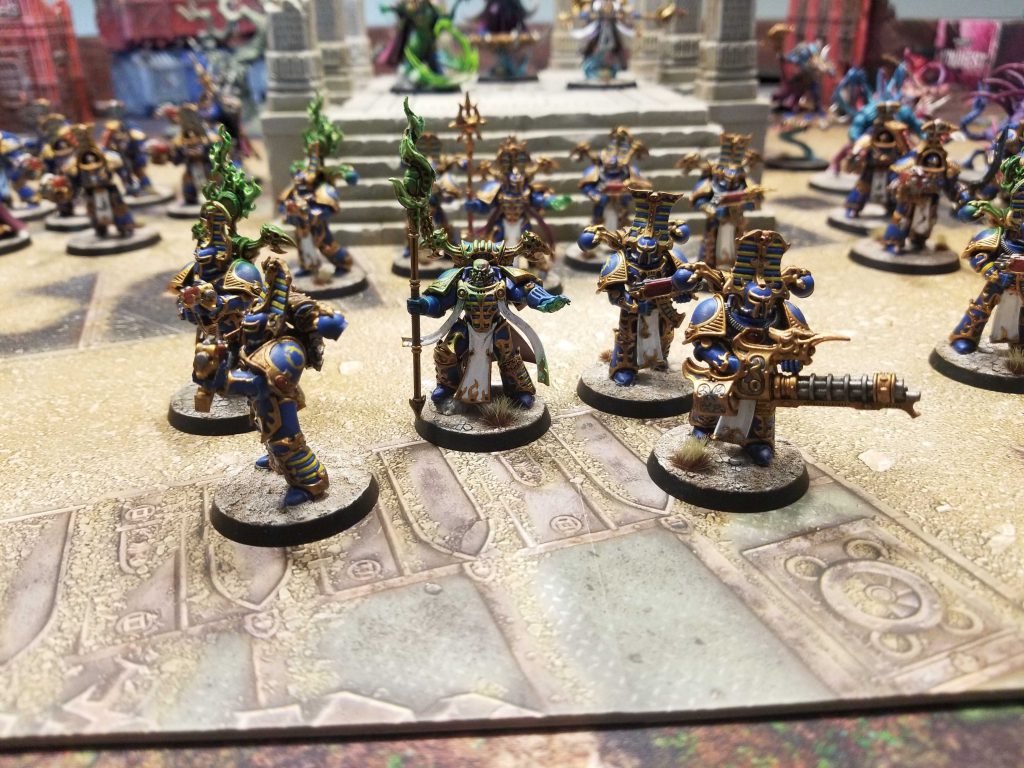
The Thousand Sons have six Stratagems to work with, and surprisingly few of them come from the Codex. Inhuman Savagery is the lone stratagem which does, giving a unit of Tzaangors re-rolls to hit in melee for 1 CP. Endurance of Aeons gives a rubric or terminator unit transhuman (costs 2 CP for Terminators), and is a nice replacement for Unwavering Phalanx in a format that’s less likely to feature lots of 2- and 3-damage attacks. Mirror Mind lets a Psyker unit manifest powers without failing an action, letting you cast while capturing an objective or going into Overwatch. Pax Diabolus brings over some flavor from the Chaos Space Marines, letting a psyker automatically drop the damage for a failed save to 0 if you cast a power. Entombed Automata lets you set up a Rubrics unit wholly within 6” of an Entry zone instead of directly on it, giving you a lot of pregame deployment flexibility. And Eldritch Accuracy lets a Rubric or Scrab unit ignore modifiers to hit when shooting and their target doesn’t get cover, helping them absolutely shred something with their AP-2 bolters.
Thousand Sons are in a weird place in Boarding Actions. Their ability to throw out mortal wounds with every unit in the psychic phase makes them very deadly, but their limited datasheets and high costs can make it difficult get everything you want into your roster. There are basically two builds you’re looking at with Thousand Sons in Boarding Actions: Three units of Rubrics, or Rubrics + Scarabs (double scarabs is possible, but taking only 3 units in Boarding Actions games seems like a mistake to me). Either way, your cheapest character options are the Infernal Master and the Sorcerer, each of which cost you 90 points and the former of which is likely the better play. One cool part about Boarding Actions is that while teleporting is very powerful the fact that Sorcerous Facade is Warp Charge 11 makes it just too unreliable to use and so there’s a lot of reason to use a different great cult. In particular, the Cult of Magic, Cult of Time, Cult of Scheming, and Cult of Knowledge all have real value in the mode. Empyric Trespass in particular can be very nasty as it has a 24” range and doesn’t require line of sight.
Either way you go, you’re likely to end up with between 5 and 8 Cabal Points per turn, which doesn’t give you a ton to work with – Malevolent Charge costing 5 means that it’ll often drain all of your charge, but the upsight is you’ll want to use Warp Sight more often. If you’re going triple Rubrics you probably don’t need Master of the Malefic Conduit; if you’re going Scarabs + Rubrics, you will want to have it so you can get off a second ritual per turn. Either way, Thousand Sons are pretty nasty in Boarding Actions, in part because you can take a buttload of warpflamers and just bathe the hallways in coruscating flames.
Adeptus Custodes
Custodes were already a force to be reckoned with in boarding actions, since a lot of their natural predators are not allowed inside a spaceship. And with the addition of these rules, they become even more powerful with some great utility and some new ways to make them even tougher than nails. For enhancements, Shard of Majesty gives you half of the Eagle’s Eye relic from the base book, providing your warlord with an impressive 3+ invulnerable save once per phase. There’s also Mantle of Sequestered Motions, which lets you advance and charge in the same turn and re-roll those rolls in a pinch.
Duty Before the Throne lets your destroyed models fight on death, ensuring that you’ll always get a chance to swing. Arcane Genetic Alchemy also returns from the codex, offering the same effect as Transhuman Physiology. Oath-Bound Protectors allows a unit to heroically intervene or, if it already could, expands the distance it can intervene to 6”, which can help a lot in the close confines of boarding actions games. Finally, and perhaps most interesting, there’s Talons Bared, which lets you open a door with enemies on the other side, then count as having charged in the fight phase. This provides very useful counterplay to a strong defensive option in boarding actions: opening a door like this usually would result in the enemy on the other side of the door fighting first, and flipping the activation order might let you clear our the enemy squad before they have a chance to fight.
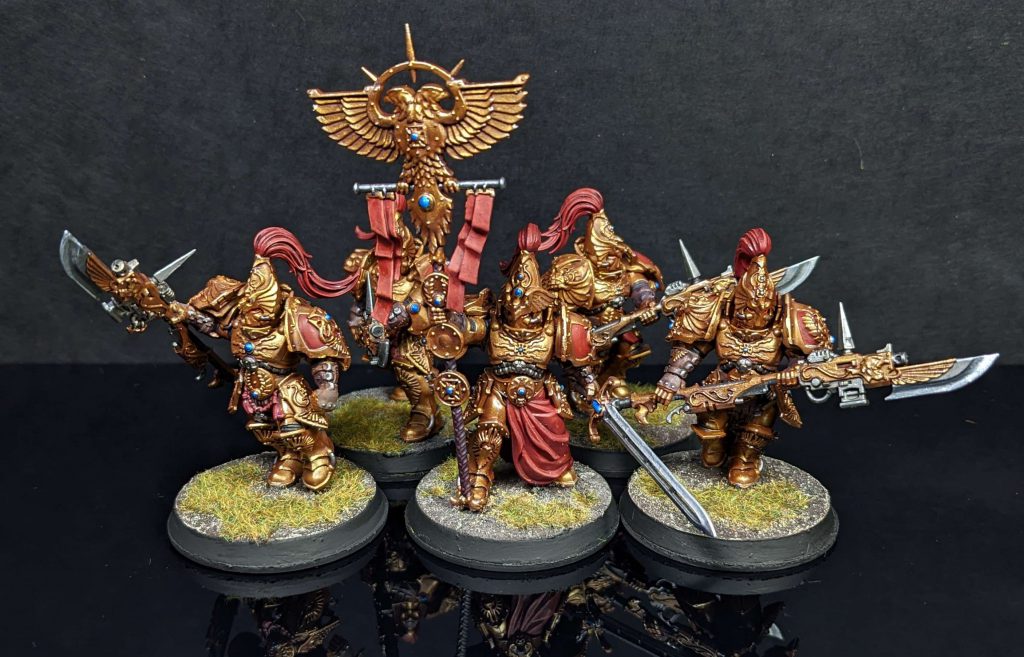
Despite their low unit count, Custodes are looking pretty good in boarding actions, particularly if you keep in mind that Sagitarrum Custodians are still legal here. Add in the options they pick up here, and they’re likely to be a force to be reckoned with on the table despite their low unit count.
One side-effect of the Boarding Actions rules is that the role Sisters of Silence play in the army feels somewhat diminished: due to the fact that all your Custodes have Objective Secured and can thus use the Secure Sites action, there’s not a lot of call for a unit to sit on a back objective not doing anything, particularly when they cost about the same as an Allarus Terminator with nearly as many wounds, a better defensive profile, and offensive output that doesn’t drop off as you lose wounds. That said, there are a few neat tricks for Sisters in here if you want to bring them: Judgment of the Void lets a Knight-Centura turn off Objective Secured for an enemy unit and interrupt Secure Sites in the bargain, and the Sense of Sanction stratagem lets them declare charges against enemy psykers they can’t see. The Golden Boys are still probably a better choice, but that’s not to say you can’t find room for Sisters in your list if you really want to.
Agents of the Imperium
The last faction included in this book honestly came as a bit of a welcome surprise. This job center for Imperial Weirdos allows you to bring most of the random stuff that’s been released in the past few years, plus a few extra surprises to boot. The number of units on offer here honestly isn’t bad: in addition to the Imperial Navy Breachers and various Arbites units that have released in the Kill Team boxed sets, you can choose between a Rogue Trader with an entourage (Elucia Vayne and the Elucidian Starstriders are perfect for this) or an Inquisitor and some Acolytes, and you can take up to 3 Inquisition characters if your warlord’s an Inquisitor. You’ve also got access to assassins, who don’t take up your character slot.
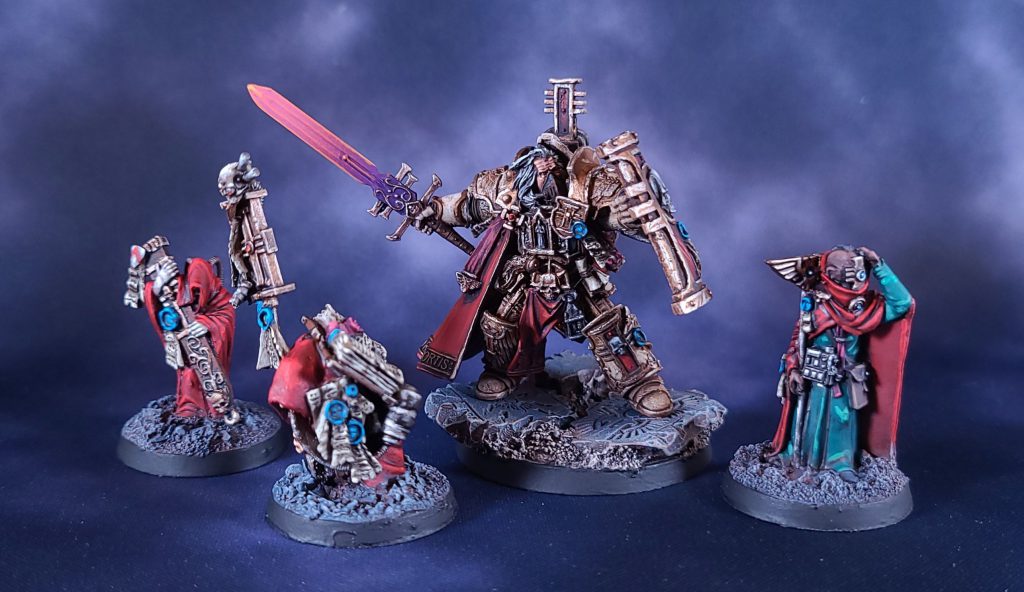
We’ll talk about the datasheets a bit more in-depth in a separate article, but it’s worth pointing out that, thanks to the fact that there are no compulsory force-org slots in a Boarding Patrol detachment, the Shipborne Personnel and Instruments of Repression rules won’t apply, so you can build your force entirely out of Navis Imperialis or Adeptus Arbites units if you want to. You also get to choose one type of unit–Acolytes, Navis Imperialis troops, or Adeptus Arbites troops–and give them Objective Secured for the game. Finally, while Arbites don’t have a character, if you bring an Exaction squad and no other characters (other than assassins), you can give the squad leader an enhancement as though they were your warlord. Neat!
Speaking of enhancements, Deck Fighter lets you pick a unit within 9” at the end of your movement phase, then have it Set Overwatch, Hold Steady, and Set to Defend. It can’t shoot in the shooting phase, but it’s a neat little trick if you want to lock down a corridor to prevent a charging enemy from breaking through. Of course, the Inquisition’s power is a bit more subtle than that, as represented by Inquisitorial Mandate, an Inquisitor-only enhancement. It not only gives the model Objective Secured, but allows them to choose an objective that they’re within range of and control at any point during a Normal Move and have it count as though someone completed the Secure Sites action on it.

The stratagems on offer also bring some nasty tricks. Concussion Grenades lets your Voidsmen-at-Arms flash and clear a hatchway, preventing enemy units within 6” of it from firing overwatch and knocking 1 off that unit’s hit rolls and preventing re-rolls until the start of your next movement phase. Strict Judgment lets an Arbites unit pick an enemy within 9” and remove Objective Secured, as well as preventing them from taking the Secure Sites action, making it a lot harder for your opponent to hold ground. If you’re looking for something a bit more direct, look no further than Uncompromising Executioners, which allows an Arbites unit to re-roll wound rolls for a phase. And don’t think that the Inquisition is left out here, either: Hatchway Expertise allows either a Navis Imperialis squad or a squad of Acolytes to open a hatchway within 1” immediately after finishing a Normal Move. It even prevents the enemy from trying to hold it shut.
This is a really cool option for a Boarding Patrol, and adds some neat ways to use models that otherwise don’t see a lot of play. Is it any good? Maybe. The datasheets for the units you can bring don’t scream “oppressive,” but they look decent enough and are reasonably priced: with most of your units clocking in just over 100 points, you can expect to have somewhere between 6 and 8 boarding squads at deployment, depending on how you built your list. Add to this some deceptively tough units in Subductors with riot shields or Navis Breachers with void armor, and some solid utility tricks in their rules and available stratagems, and you’ve got a force that at the very least looks like it’ll be interesting on the table.
Regardless of how it plays though, this is a definite win for anyone looking to get some of their Imperial Weirdos out on the board. The extreme flexibility in building your Boarding Patrol lets you run all sorts of cool forces: whether you want to build an Inquisitor’s retinue with Acolytes, a Daemonhost, and a Jokaero tagging along; the valiant forces deployed to a Rogue Trader’s flagship struggling to repel boarders and defend their liege’s interests; or a dogged patrol of Arbites hunting heretics through the bowels of a derelict warship, these rules let you do that.
The Missions
Also included are two sets of missions: Dread Encounters, which are set-piece missions with some of the coolest mission rules in the entire Arks of Omen series–or all of 9th edition, for that matter–and Breaching Operations, which are a set of missions that use the destructible walls from the Kill Team: Soulshackle box to set up boards where some of the terrain can be destroyed, either by your units attacking them with heavy fire power or, if they’re big enough, just barreling through them in the charge phase.
Breaching Operations
We’ll start with Breaching Operations, because they’re the most straightforward: the missions here have a similar feel to the ones in Abaddon and Angron, but with a twist: some of the walls are destructible.
When you set up the board, some of the wall sections will be the “Weakened Wall” sections from Kill Team: Soulshackle. These sections can be breached in one of three ways: 1) you can shoot at it with a weapon with strength 6 or higher, 2) a model with at least toughness 4 and 3 wounds can perform a “bulldozing charge” to try to run right through it, or 3) your Warlord can take the new Breaching Charges enhancement to set a charge they can detonate on command. Regardless of how you get it done, though, enemy units on the other side who are close enough are at risk of taking a mortal wound from the debris.
In addition to Breaching Charges, there are two other new enhancements: Spoor Seeker, which lets your Warlord scan through unbreached weakened walls to give +1 to hit and wound to other friendly units firing at the target, and Paralysing Assault, which lets your Warlord zap someone through a weakened wall section, knocking them out of Set to Defend, stopping them from firing Overwatch, and imposing a -1 penalty on all hit rolls for the turn.

Other than these changes, the missions are mostly more of what you expect. There’s new terrain objects in the Hatchway Jammers, which prevent a hatchway from being opened from one side until removed, and Data Consoles and the Hololith Dais, which are terrain pieces you can control, and which add some more texture to objectives and other gimmicks on the maps.
Predatory Acquisition is fairly straightforward: a six-objective map that sees you scoring for holding one, two, or three objectives, with an additional 5 points for holding more than your opponent, followed up by a 10-point kicker at the end of the game if you took out your enemy’s Warlord. Unsleeping Eyes uses the Data Console terrain pieces, and if you control them, your units can use the facility’s security cameras to keep track of where their enemies are, counting as Holding Steady and being Set to Defend whenever they’re not engaged with an enemy. Priority Access has four objectives, but on any given round two of them count double for scoring, and which pair are “on” is randomly determined at the top of each round. And Demolition Corps does away with objectives entirely, tasking the Attacker with blowing holes in weakened wall segments that lead into the ship’s reactor room, potentially causing mortals to anyone within 6” as the reactor’s radiation flares out after the breach.
These missions are broadly pretty good. There’s a solid mix of symmetric missions that are great for pickup games together with some weirder ones that would be great to run with a friend to really mix things up when you’re looking for something a little different. Not only that, but they make excellent use of the unique terrain pieces in the Soulshackle box. And while the only way to get breaching charges is by taking the enhancement of the same name on your Warlord, most armies are going to pretty easily be able to take at least a handful of special or heavy weapons that will make short work of a wall section if you want to take one out. Combine that with some interesting mission designs playing around with the Data Consoles and Hololith Dais, and you’ve got a solid set of missions that are definitely worth a look.
Dread Encounters
The other stuff in this book may be pretty good, but this is the good shit. Dread Encounters are the coolest and most cinematic missions in the entire Arks of Omen series, and are honestly in the running for some of the best missions GW has put out through all of 9th edition. Each mission is set in a very specific place in the story of the Arks of Omen, and has special rules to evoke exactly the setting that they’re going after. And boy, do they knock it out of the park.
Start with the first one on offer: The Red Angel’s Wake. You’re fighting on an Imperial frigate right smack in the middle of a fleet action, scrapping with your opposite numbers over six objectives. Scoring is simple enough: hold one/two/more, with a bonus 10 points for controlling one of the two “Prime” objectives near the center of the board. Then, starting at the top of the second round, the attacker rolls a d6. If the result is less than or equal to the current battle round, Angron decides to make an appearance, diving through the ship you’re on, causing it to break in two. At this point, you split the two boards you’re fighting over so they’re 4” directly apart from one another, then continue the game as normal. You can still shoot across the gap, but you can’t move or charge between it. Oh, and if your unit happened to be straddling the middle of the board when it split? There’s a chance that models in that unit will fall into the deck rupture, tumbling into the void and instantly dying. Hell yeah.
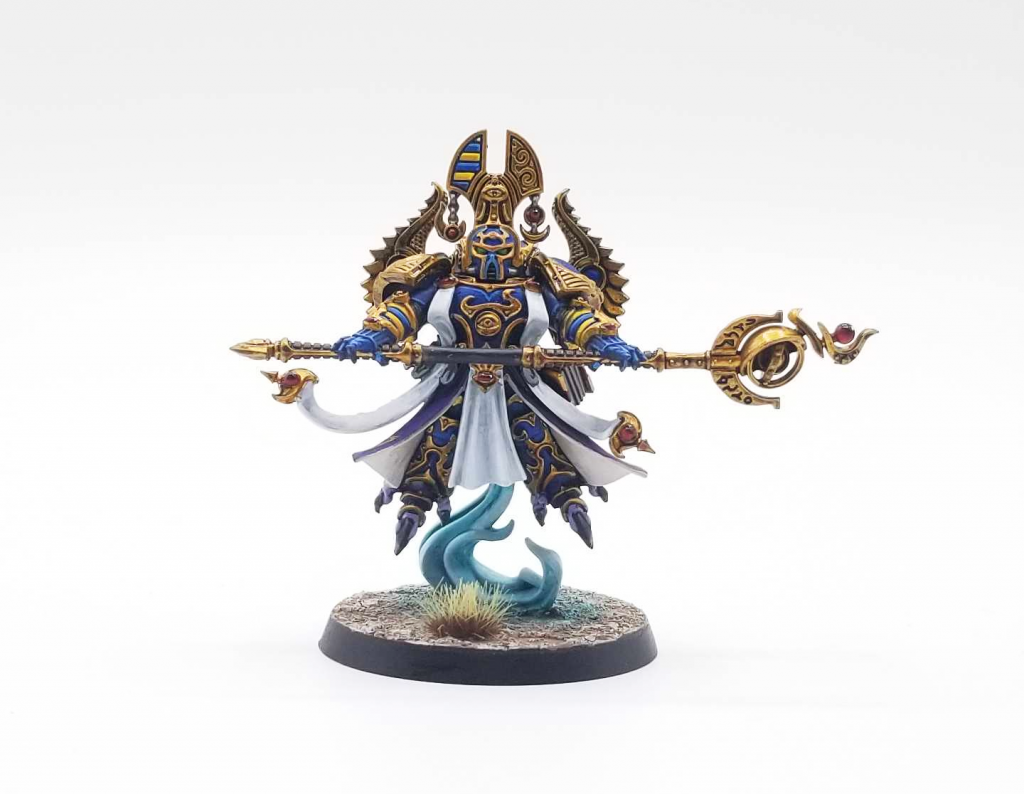
If the units in your Boarding Actions games aren’t big enough for you, there are two options to bring in the big guns. Macro-Junction IV-B gives each player a “Critical Threat” as part of their roster: this is something like a Dreadnought, a Monster with 10 wounds or less, a Broadside, or something sized models. They have limited deployment options, and can’t go through hatchways, but there’s plenty of open space on the map for them to lumber around in, and you can’t hold objectives without going somewhere they can get to.
Seize the Engine Dock, on the other hand, only lets the defender take a big unit, but it can be any Heavy Support vehicle unit. There’s a catch, of course: the “docked” vehicle can only set up in one particular entry zone, and it can’t move at all during the game. Additionally, one of the spaces on the board is marked as the “Elevator Controls.” If the attacker can make it to that square and perform an action that completes at the start of their next turn, on a 4+ they manage to activate an elevator under the vehicle, pushing it to another deck and out of the field of battle.
And what’s a book titled The Lion without a mission tailor-made for The Lion to do The Lion things? Thankfully, this is a question we don’t have to answer, since Slay the Night Terror is right here. This mission is explicitly designed for the attacker to include a single, powerful combat model like Lion El’Jonson, and one look at the map will tell you why: the attacker deploys in a small room, then has to run a gauntlet to make it to the sole objective on the board, representing the Ark of Omen Night Terror’s daemonic pilot. The defenders, on the other hand, have deployment zones all over the board, and have to stop the attacker from ending a round next to the objective. If the attacker manages to get there, each unit that does has a chance to deal damage to the Ferryman, but at the cost of dishing out mortal wounds to everyone nearby. Put 3 damage on the Ferryman this way, and the attacker wins. Otherwise, it’s a 90-0 victory for the defender.
Final Thoughts
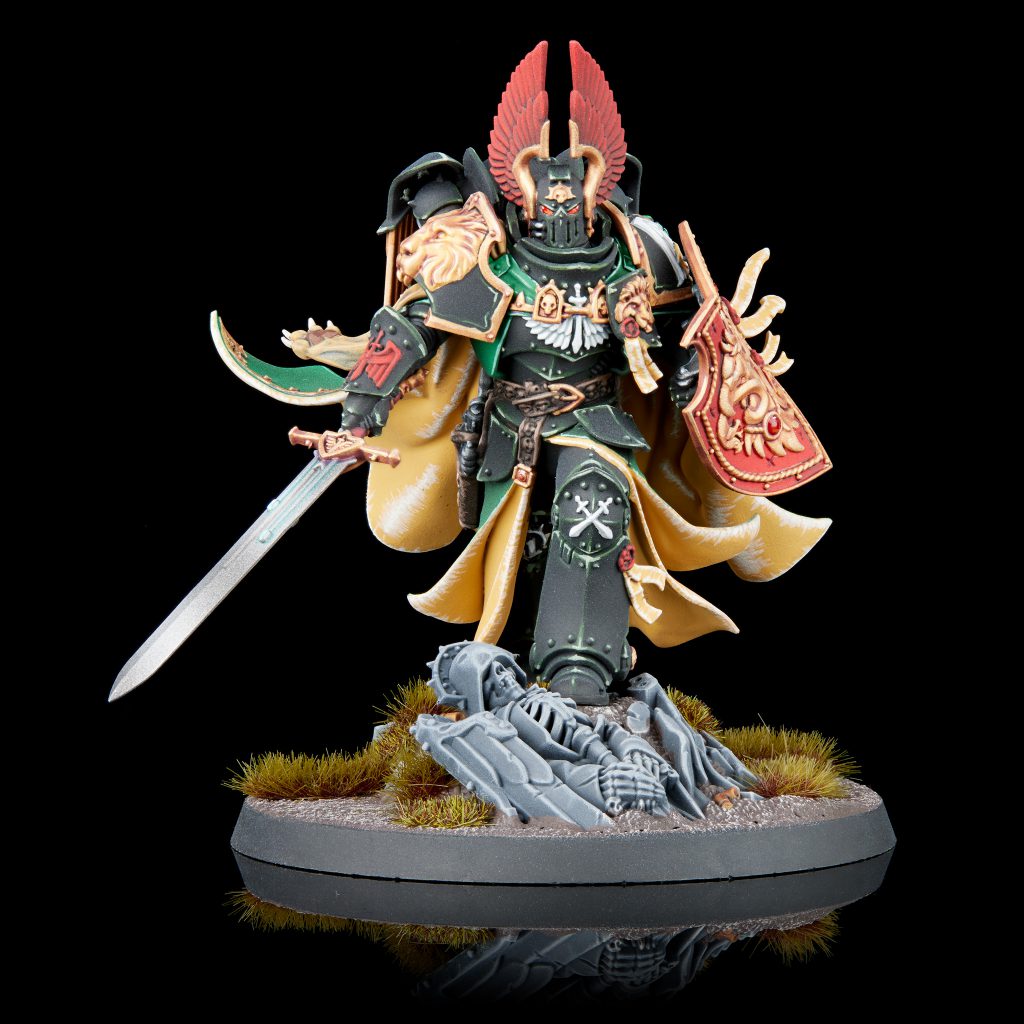
Condit: This is the best release yet in Arks of Omen. Obviously, Votann, Thousand Sons, and Custodes players are going to need this book to play their factions, but even if your playgroup doesn’t include anyone meeting those criteria, you’re going to want this at your table. The Dread Encounters missions are worth the price of admission alone, between the cinematic set-piece missions and the missions that let you bring in units that you’d otherwise never see in this format. And if you’ve got access to the terrain bits that came in the Soulshackle box, the Breaching Operations are every bit as good as the missions that came in Abaddon and Angron.
As an added bonus, the book includes printed versions of the datasheets for Lion El’Jonson, Commander Dante, and the various Agents of the Imperium units that have been released for Kill Team. Given that those datasheets are available for free on Warhammer Community, it’s not worth picking up the book if that’s all you’re looking for. But if you’re reading this review, you’re probably considering picking up the book for the new missions anyway, and if that’s the case having the datasheets in print is a nice bonus.
All told, this is my favorite book they’ve released in what has been my favorite series of campaign books for 40k. The lore was a fun read, the faction rules are solid, and I’m already champing at the bit to schedule as many opportunities to play these missions as I can. If you like the Boarding Actions format at all, you are definitely going to want a copy of this book to play with.
Rob: This is the best campaign book GW has ever released. Period. Great story here, tons of rules, lots of content. If you’re playing Boarding Actions games, there’s a ton here to keep you occupied and do cool missions where you blow holes in walls. This is the kind of value I wish they’d put in more of their campaign books, and while a couple of them came kind of close – this is the gold standard.
Have any questions or feedback? Drop us a note in the comments below or email us at contact@goonhammer.com.


